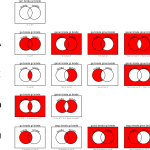
For my own reference, I have illustrated the 14 possible truth functions that can be expressed using the A, E, O and U connectives in Lojban, and annotated them with the most appropriate forethought connective to do the job.
In many cases, there are multiple ways to express a single truth function. For example, {gonai broda gi brode} is logically equivalent to {segonai broda gi brode} and {go broda ginai brode} and {sego broda ginai brode}, but despite the fact that they are well-formed Lojban there is literally no reason to ever use those constructions, and ones like {go … ginai …} kind of defeats the purpose of using a forethought connective in the first place. Mutatis mutandis with {ga … gi …} vs {sega … gi …}, etc.
Of course, since there’s 4 regions of the Venn diagram that could be shaded or not, that makes 24=16 possible truth functions. The topmost Venn diagram is the forethought-connected question, not an attempt at the truth function where all the regions are unshaded. So what happened to the remaining two functions? It is not possible, using the regular Lojban connectives, to make a Venn diagram that would be all white or all red. Fortunately, as the CLL says, these are “pretty useless anyway.”
Come to think of it, how would I render those into English? “A or B or both or not A or B?” and “Not A and Not B and not not A or B?” Gross.
For a more legible version, see the attached PDF: Truth functions
